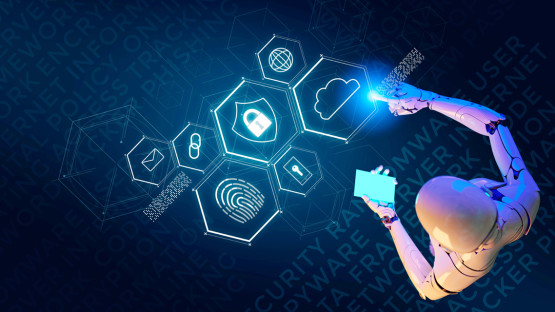Ads
Protecting personal and business information has never been more critical than in today's digital age. With the rise of cyber threats, the use of artificial intelligence (AI) in cybersecurity is becoming a pressing need. But how can we harness its full potential without taking risks?
In this comprehensive analysis, we'll unravel the vital role AI plays in cybersecurity. We'll explore its many benefits, such as proactive threat detection and rapid incident response, as well as how it can provide an additional layer of protection for your information.
Ads
In addition, we will also delve into the challenges and risks associated with the use of AI in cybersecurity. This will include a discussion of the privacy and ethical issues that may arise, as well as how to properly mitigate them.
Likewise, we'll take a look at emerging trends and future prospects in this field. This will help stakeholders understand how they can adapt to changes and stay ahead in the fight against cyber threats.
Ads
Finally, we'll provide practical tips and guidelines for safely implementing AI into your cybersecurity strategies. Whether you're protecting personal information or sensitive corporate data, this analysis will help you make the most of AI in cybersecurity without taking unnecessary risks. Get ready to delve into the fascinating world of artificial intelligence and cybersecurity!

Artificial Intelligence in Cybersecurity
Artificial intelligence (AI) has revolutionized the field of cybersecurity, providing solutions that can predict, detect, and respond to threats with unprecedented efficiency. AI It is capable of processing and analyzing large amounts of data at speeds that exceed human capabilities, resulting in faster detection and response to security threats.

AI in threat prediction and detection
AI can be used to predict and detect threats before they occur. By using machine learning algorithms, it can analyze behavioral patterns and detect anomalies that may indicate a threat. For example, if a user attempts to access a large number of files in a short period of time, this could be an indication of suspicious activity. AI can detect this activity and alert security administrators so they can take action.
AI in threat response
Once a threat has been detected, AI can help respond effectively. It can automate certain processes, such as isolating affected systems, to minimize damage. Additionally, AI can help identify the source of the threat, providing crucial information to prevent future attacks.
How to leverage AI in cybersecurity
To fully harness the potential of AI in cybersecurity, it's important to consider certain aspects.
Implementation of AI solutions
First, the right AI solutions must be selected and implemented. This may involve hiring a team of AI specialists or acquiring pre-existing AI solutions. Some popular solutions include AI-based intrusion detection systems and security analysis tools.
AI Training
Once the AI solution is implemented, it's essential to properly train it. This involves feeding it relevant data so it can learn and improve its detection and response capabilities.
AI Maintenance
It's important to perform regular maintenance on AI to ensure it's functioning optimally. This may include updating algorithms and monitoring AI performance.
Risks of AI in Cybersecurity
Despite its benefits, AI also presents risks in the area of cybersecurity.
Dependence on AI
An overreliance on AI can lead to a false sense of security. While AI can efficiently detect and respond to threats, it is not infallible. Cybercriminals are constantly finding new ways to circumvent security defenses, and AI cannot anticipate all possible attack tactics.
Privacy risks
AI requires access to large amounts of data to function effectively. This raises privacy concerns, as sensitive data can be compromised if the AI is hacked.
Misuse of AI
Like any technology, AI can be used for malicious purposes. Cybercriminals can use AI to carry out more sophisticated and difficult-to-detect attacks.
Protect your information with AI
Despite the risks, AI has great potential to improve cybersecurity. Here are some ways to protect your information using AI:
- Use AI to monitor and analyze behavior on your network, detecting anomalies that may indicate a threat.
- Implement AI solutions that can automatically respond to threats, minimizing damage.
- Train your AI with relevant data to improve its ability to detect and respond to threats.
- Keep your AI up to date and regularly monitor its performance.
- Implement security measures to protect the data your AI uses, minimizing privacy risks.
Artificial intelligence can be a powerful tool in the fight against cyber threats. However, as with any technology, it's important to use it responsibly and be aware of the potential risks. With proper implementation and maintenance, AI can provide a valuable layer of security in protecting your information.
Conclusion
In short, artificial intelligence (AI) has proven to be a powerful tool in the field of cybersecurity, with the ability to predict, detect, and respond to threats with unprecedented efficiency. However, like any technology, its use must be handled with caution and awareness. To fully harness AI's potential, it is crucial to select and implement the right AI solutions, train them effectively, and perform regular maintenance. Furthermore, it is vital to consider risks, such as overreliance on AI, privacy risks, and AI misuse. AI can be an invaluable ally in the fight against cyberthreats, but only if used responsibly and securely. Ultimately, AI has the potential to provide a valuable layer of security in protecting our information, as long as it is implemented and maintained properly and conscientiously.



